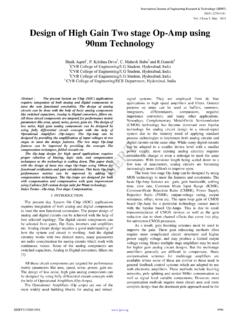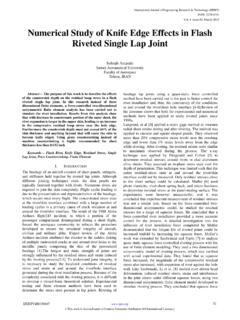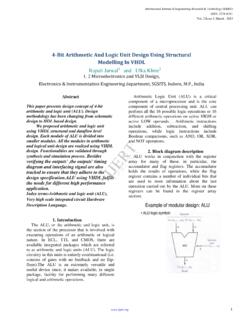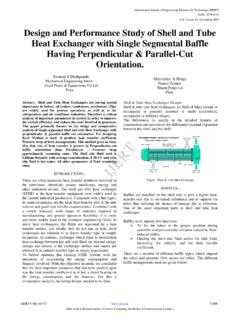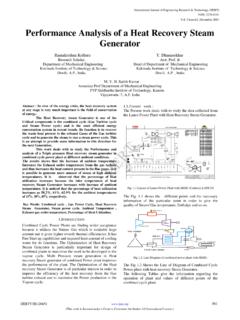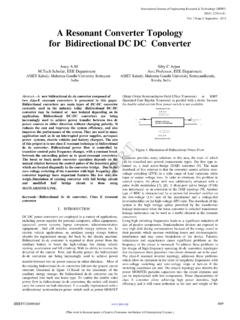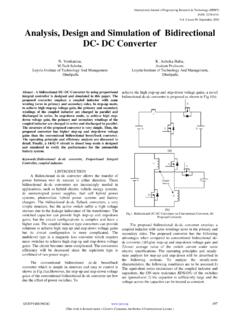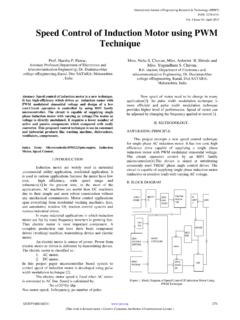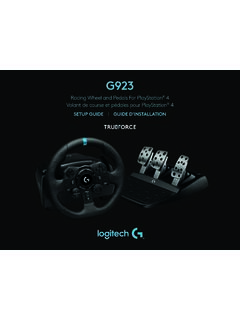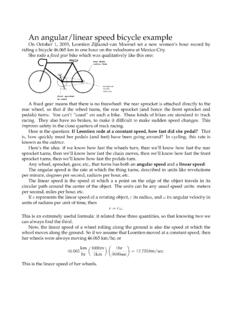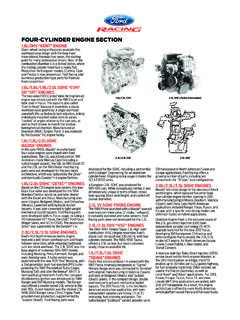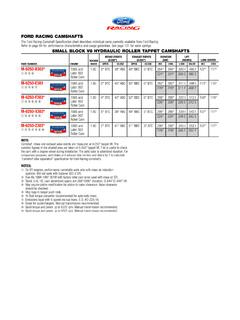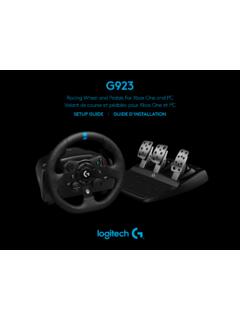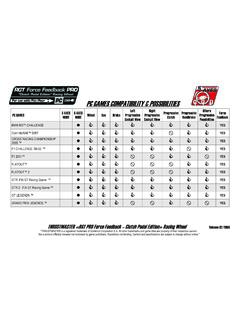Transcription of Design of Formula One Racing Car - IJERT
1 International Journal of Engineering Research & Technology ( IJERT ). ISSN: 2278-0181. Vol. 4 Issue 04, April-2015. Design of Formula One Racing Car Triya Nanalal Vadgama Mr. Arpit Patel, Student Assistant Professor Department of Aeronautical Engineering Department of Aeronautical Engineering Sardar Vallabhbhai Patel Institute of Technology, Vasad Sardar Vallabhbhai Patel Institute of Technology, Vasad Gujarat Technological University, Ahmedabad, India Gujarat Technological University, Ahmedabad, India Dr. Dipali Thakkar, Head & Professor Department of Aeronautical Engineering Sardar Vallabhbhai Patel Institute of Technology, Vasad Gujarat Technological University, Ahmedabad, India Abstract- A modern Formula One (F1) Racing Car has almost as affect the airflow, and placing a badge on a crucial element much in common with an aircraft as it does with an ordinary could produce a two-to-three percent difference in air road car.
2 Aerodynamics has become a key to success in the sport pressure. Disrupted air flow can cause turbulence, which will and teams spend millions of dollars on research and produce drag to slow the car. F1 cars often have small development in the field each year for improving performance. 'winglets' before the rear wing, which 'clean up' complex air The aerodynamic designer has two primary concerns : i. the creation of downforce, to help push the car's tyres flow in order to maximize down force. The scope of this onto the track and improve cornering forces, project includes : ii. to minimise the drag that occurs due to turbulence and i. Designing of F1 three-dimensional CAD model acts to slow down the car. using CATIA V5 R21 software. In this project, a Formula One race car will be designed using the CAD software CATIA V5R20.
3 All the dimensions are based The CAD model will be rectified before simulating it. The on the standards laid down by the FIA (F d ration corrections are necessary to ensure an accurate representation Internationale de l'Automobile). The car Design will be of the aerodynamic geometry of the car. These will be done enhanced to streamline the flow over the car. Various parts that in three steps: will be designed include the wheels, front and rear airfoils, front and rear wings, car body chassis, among other subassemblies. A i. Assembling missing components, driver will also be placed in a typical driving position inside the ii. Redesigning lost parts or parts that were missing, car. iii. Resizing components with accurate dimensions and features. Keywords- Formula One race car, Airfoil, Aerodynamics, Body chassis, driver.
4 The internal geometry, such as the engine and transaxle, will I. INTRODUCTION not be included as the primary focus of this project is external flow. As such, the internal parts will be removed from the On the surface, automobile Racing appears simply as a CAD model. popular sport. But in reality, Racing serves as a proving ground for new technology and a battlefield for the giants of A. Formula One Background History automobile industry. Although human factors are frequently The Formula One (F1) World Championship is the publicized as the reason behind the success or failure of one highest class of single-seat auto Racing in the world. It is Racing team or another, engine power, tire adhesion, chassis sanctioned by the FIA (F d ration Internationale de Design , and recently, aerodynamics probably play a very l'Automobile).
5 Formula One cars can reach speeds upto 330. important role in winning this technology race. km/h. The FIA controls and regulates all the sizes and dimensions of Formula One car. These strict regulations led One of the most important aspects of Formula One (F1) to similarly-dimensioned cars. A typical car will be 463cm car Design is aerodynamics. Creating down force, to hold the long, 180cm wide and 95cm high. car to the ground to improve cornering; and minimizing drag, which slows the car down are two primary concerns when Flexible bodywork, with the exception of the rear-wing, is designing the car. Modern F1 teams use expensive wind strictly prohibited. Moreover, any device, system or tunnels and computational fluid dynamics systems to analyze procedure which uses driver movement to alter the the effectiveness of an aerodynamic Design for a car.
6 In these aerodynamic characteristics of the car's bodywork is strictly analyses, every surface of the car, including the driver's prohibited. Sections of bodywork, such as front wing end- helmet must be considered. Even an advertising sticker can IJERTV4IS040962 `. 702. (This work is licensed under a Creative Commons Attribution International License.). International Journal of Engineering Research & Technology ( IJERT ). ISSN: 2278-0181. Vol. 4 Issue 04, April-2015. plates, are required to be sufficiently thick to prevent damage to tyres of other cars. B. Ferrari F10 Background The Ferrari F10 is built by Scuderia Ferrari Marlbolo. 1) Specifications : Chassis: Carbon fiber and honeycomb composite structure Gearbox: Ferrari 7-speed (+reverse) longitudinal gearbox Differential & gearbox: Limited slip differential, Semi-automatic sequential electronically controlled gearbox Brakes: Ventilated carbon fibre disc brakes Suspension: Independent suspension, push rod activated torsion springs, front and rear 2) Engine : Engine: type 056.
7 Cylinders: V8 90 . Fig. 3 Top View of F10. Cylinder Block: Cast Aluminium Number of Valves: 32, C. Aerodynamics Background Pneumatic Distribution Aerodynamics is a branch of dynamics concerned Total Displacement: 2398 Cm . with studying the motion of air, particularly when it interacts Piston Bore: 98 Mm with a moving object. Aerodynamics is a subfield of fluid Weight: 95 Kg dynamics and gas dynamics, with much theory shared Injection: Magneti Marelli between them. It is often used synonymously with gas Digital Electronic Injection dynamics, with the difference being that gas dynamics Iginition: Magneti Marelli applies to all gases. Static Electronic Ignition Fuel: Shell V-Power Understanding the motion of air (often called a flow Lubricant: Shell Helix Ultra field) around an object enables the calculation of forces and moments acting on the object.
8 Typical properties calculated 3) Dimensions : for a flow field include velocity, pressure, density and Wheelbase: 3050mm temperature as a function of position and time. By defining a Front Track: 1470mm control volume around the flow field, equations for the Rear Track: 1405mm conservation of mass, momentum, and energy can be defined Overall Length: 4545mm and used to solve for the properties. Overall Height: 959mm Overall Width: 1796mm Aerodynamics has become key to success in the Overall Weight: 600kg, Formula One sport and spends of millions of dollars on including driver and camera research and development in the field each year. The Wheels, Front And Rear: 13". aerodynamic Design has two primary concerns. i. The creation of downforce to help push the car's tires onto the track and improve the cornering force.
9 Ii. To minimizing the drag that caused by turbulence and act to slow the car down. The drag over a body can be minimized by streamlining it (smooth exterior surface). As a result, there will be potential improvements in fuel economy. [ & 5]. Fig. 1 Front View of F10. Fig. 4 Flow Over A Streamlined Body (Courtesy of Race Care Aerodynamics By Joseph Katz). Fig. 2 Side View of F10. IJERTV4IS040962 `. 703. (This work is licensed under a Creative Commons Attribution International License.). International Journal of Engineering Research & Technology ( IJERT ). ISSN: 2278-0181. Vol. 4 Issue 04, April-2015. Fig. 5 Aerodynamic Forces Fig. 8 Schematic description of the flow field over an open-wheel F1 race (Courtesy of Race Care Aerodynamics By Joseph Katz) car. (Courtesy of Race Car Aerodynamics By Joseph Katz).
10 D. Selection of Airfoil NACA 4-series airfoils are the most widely used airfoils for Formula One race cars. The NACA four-digit wing sections define the profile by: i. First digit - maximum camber as percentage of the chord. ii. Second digit - the distance of maximum camber from the airfoil leading edge in tens of percentage of the chord. iii. Last two digits - maximum thickness of the airfoil as a percentage of the chord. Fig. 6 Schematic description of the Ground Effect that increases the aerodynamic lift of the wings when placed near the ground. (Courtesy of Race Care Aerodynamics By Joseph Katz). 1) Front Wing Airfoil NACA 4412. The Front Wing of a Formula One car creates about 25% of the total car's downforce. This is one of the most widely used spoiler airfoil, but needs to be enhanced as per speed.

